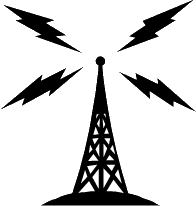WSFA
As the anticipated mass and height of the Tower became generally known, a hue and cry rose from a very specialized group of citizens connected with line-of-sight broadcast systems – radio, television and radar. Suddenly yours truly was beset with technicians bitterly complaining that we were going to interrupt their “vital signals”.
First to appear was WSFA-TV, who excitably predicted that our design would block their “Tower-cam” relay signal from reaching the Civic Center. Most people think the camera and the relay tower up on the hill by the Persons State Office Building is just used to make live shots for the weather report. However, the real purpose of the system is to relay mobile truck telecasts from any point downtown out to the WSFA studio three miles south of downtown. The engineers for the TV station were all upset that we were going to spoil a system that worked so well for them.
The issue rocked along unresolved for two years until the building structure had reached its final height, when WSFA’s renowned news anchor Bob Howell appeared at my office with the station’s Chief Engineer, Ken Thayer, to beg that they be allowed to install a signal relay system on the Tower roof. They brought along full-size foam-board models of the signal horns that they proposed to erect.
I dutifully relayed their request to Dr. Bronner, who chuckled as he remembered the uproar that was created five years earlier when he had attempted to buy the station. Bronner was agreeable to the proposal provided WSFA pay all the costs to prepare the roof utility gutter to accommodate the transmission system, and provided PH&J make the same offer to every other TV station in Montgomery. The Tower’s roof gutter, by the way, is hidden behind the gold-plated floodlight shields and is big enough to hold an automobile.
We obediently wrote each station, but none besides WSFA was interested. A short time later we proceeded to re-engineer the structure, lighting, power, etc., to accept the sending and receiving horns. Unfortunately the contractor’s cost proposal for the modifications exceeded $50,000 and WSFA declined the offer. Obviously, our biggest station found some other way to deliver live coverage of Civic Center events.
Radio Stations
Next to appear and protest our building project was a representative from Bobby Lowder’s Colonial Broadcasting empire. It seems that the broadcast studios of its several radio stations were in the Colonial Bank Building on Court Square, and that their signals were transmitted by microwave dish direct to a transmission tower just east of Eastbrook Shopping Center.
The technician who came to our office was Colonial’s chief engineer. He railed that our Goliath of a building was going to completely block their signal between the studio and the transmission facilities. He was more or less resigned to the fact, and just wanted to be sure that Colonial correctly understood what we were about to undertake. I assured him that he had the right information. Because Lowder had bluffed Auburn out of the RSA’s Alabama Center for Commerce building, I could not help but feel there was at least a smidgen of justice afoot in the situation.
The FAA
It was some eight months after we started design work on the Tower that it dawned on job captain Vic Hunt and myself that we were proposing a building of sufficient height to require Federal Aviation Administration clearance for “Obstruction Evaluation”. Yours truly certainly did not want to admit to Dr. Bronner that he had hired such country bumpkins that they could overlook the requirement, and not even secure instructions as to aviation hazard lighting.
Vic and I hurriedly drafted a letter to the FAA regional headquarters in Atlanta and enclosed pertinent data on our proposed structure. It took an agonizing eight weeks for the agency reply to reach us, but in the interim, we pressed on with design development, steadfastly ignoring the possibility that the FAA would kill our project dead. Each day I would nervously ask Vic, “Have you heard yet?”
Finally we received official approval, which had been delayed because our building was almost in a Maxwell AFB glide path. We even obtained approval of our hazard lighting scheme, which the FAA felt met their criteria. We all heaved a sigh of relief. It’s especially good to luck out when you’ve been remiss.
Then, a short time later we received another letter from the FAA saying our petition was under review, worded as if the first letter had never been sent. Telephone calls demanding an explanation came to naught because no one there would acknowledge the first letter. Vic and I were told that the person whose name was affixed to the initial letter “had retired”. The situation was unnerving to say the least, but we pressed on with the Tower plans, fearing the worst.
Many months later at least a partial explanation came out. It seems our building was going to wipe out a sector of the Maxwell AFB air controllers’ radar vision, producing an unacceptable blind spot on the lee side of our structure. The FAA was negligent in not discovering this before the first letter, and all the subterfuge was a cover-up for its earlier oversight. The radar matter was serious and would preclude construction to the design height.
But by some sort of divine luck which follows Dr. Bronner, the government coincidentally decided to transfer the Maxwell air control responsibility to Dannelly Field, and the problem went away. As you might expect, no one in the Federal Aviation Administration ever acknowledged or retracted the first letter.
-Charles Humphries (“Peril and Intrigue Within Architecture”)
This is one of many RSA Tower stories. The rest can be found here.